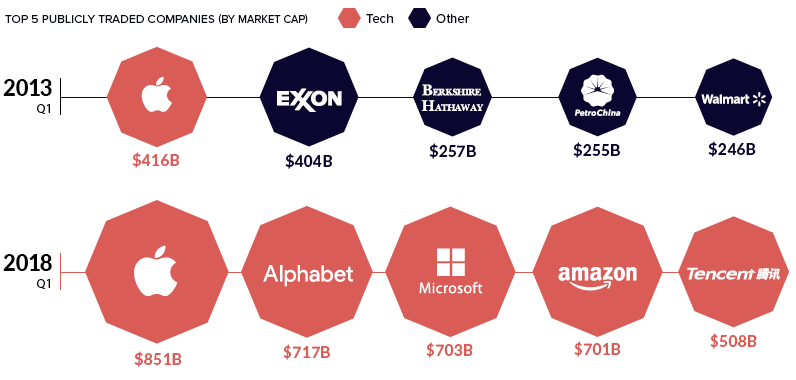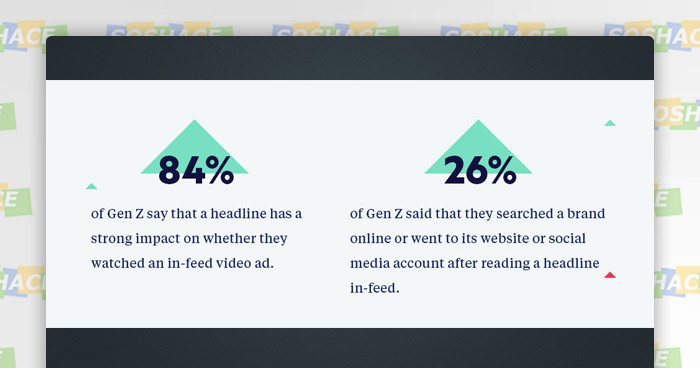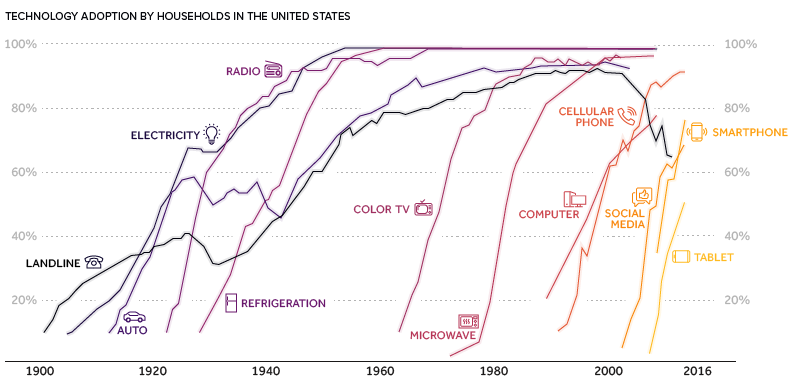
The world economy is quite a complicated subject to discuss. With such a vast amount of different factors that influence it, is it actually possible to talk about the world economy and avoid being biased or ignorant? It is possible — if we talk within our area of expertise, which is technology and remote work. And it just so happens that there are a few technological factors that shape the world economy of tomorrow.
Reiterating one of our most favorite phrases (Obvious is only obvious in the retrospect
), the creative geniuses at Visual Capitalist produced an extensive analysis of how the world economy is changing — and we will add additional insights to this discussion.
In this article, we will study how certain forces of economy shape the world — and what actual impact this may have on our everyday lives and workflow. Among these factors are: the rise of tech companies and Generation Z, the evolution of global wealth, and rapid technological progress.
Tech leviathans

A major distinction of a successful business is its ability to scale — expand in a proportional and profitable way. Industrial companies have always been fueling their businesses with additional resources. However, production of physical goods always reaches certain limits, as there is only so many man-hours and only so many resources — and scaling beyond these limitations may require something more elegant than just building more and more factories.
This is why companies which embraced technological advancements benefited from their decision: optimizing every aspect of manufacturing, they finally had the opportunity to overcome their natural limitations — and for that, they paid tech companies handsomely. As time went on, it all came down to a clash: products versus services. As other companies offered material goods, tech companies offered meta-value — they created platforms which could be used to make businesses more efficient and help people become more productive. As it turned out, the value that tech companies bring to the table is greater than that of traditional industrial companies’ — at least this is what the market thinks.
The notion of “meta-value” can be illustrated by companies like Microsoft and Amazon, whose gargantuan market capitalization can be attributed, in part, to their cloud solutions and web services — meaning that they offer platforms for other companies to run their businesses on. We can take a look at their revenue streams:
- Apple is a hardware company
- Alphabet is an advertising conglomerate
- Microsoft is a software company
- Amazon is a retail company
- Tencent is a media conglomerate (incorporating China’s social media, ads, and gaming platforms)
However, this is an oversimplified outlook at their businesses — we cannot say that Amazon, for instance, is just a retail company. These companies understand that their main sources of income (be it phone manufacturing or products sale) are volatile — and so they diversify their businesses and try to become the go-to providers of infrastructure: cloud computing, services, and web platforms.
How is this related to remote work? Tech companies have always been the pioneers of remote workflow, re-thinking and re-imagining the needs of professionals and their working environment. With the world’s most valuable companies all being tech-oriented, it would be fair to expect that remote work may become the new standard, as these companies have become masterful at capitalizing on remote workers’ workflow.
Gen Z

A quick google search on “Generation Z” will net us an endless stream of articles in which the authors all try to guess what this generation will be like. As sociologists have yet to agree even on Gen Z’s time frames, it may be difficult to pinpoint how exactly this generation can be different from millennials. Some articles would even go as far as to claim that, say, “Gen Z is 13% better with money management.” However, trying to attribute a set of features to a whole generation is not always a good idea; instead, we can examine a single distinction that may set Gen Zers apart — and it just so happens that this one distinction is work-related.
As discussed in our previous article, there is an upcoming paradigm shift in the learning environment: with the mass adoption of VR and AR solutions, new generations will be much more comfortable with the idea of a virtual workspace. Having started using VR and AR devices already from elementary school, Gen Zers will regard them as just another set of productivity tools — and wonder: “Why did our parents were so skeptical of this tech?”
How can it influence remote work? Being open to relocation far more than previous generations, this new workforce values the feeling of meaning that their company provides to them; tech-savvy and ready to start paying their large student debts off, they are willing to utilize tools of remote work to their maximum potential.
Global Wealth

Living an in era of economic prosperity, we start to take it for granted and ignore the fact that the wealth landscape may be changing. As predicted by the World Bank, China, USA, and India will be the leaders in estimated global growth in real GDP.
Countries like China and India are finding themselves in a tricky situation: their national tech companies are on the rise, but how to ensure that overpopulation in major cities does not hinder their progress? The answer may lie in remote work, as remote workers might prove to be more efficient in hectic Chinese and Indian environments: having no worries about getting to work in time, they can concentrate on actual working instead.
How can this affect remote work? Feeling that their skills are not in demand, millions of Chinese and Indian professionals decide to “export” themselves with the help of their expertise to the Western companies. In this situation, tools of remote work can serve both causes: these remote professionals can work either for Amazon or Tencent — whichever they choose.
Rapid Tech Progress

There is a great observation made in one of the Wait But Why? blog posts: if you used a time machine to take a person of the 14th century to the 15th century, they wouldn’t be surprised at the difference: hardly anything changed in this time span. However, if we take a person of the 20th century to the 21st century, they would be awestruck: the advent of transistors, for instance, has single-handedly globalized the entire human society.
This fun thought experiment illustrates a curious trend: with time, adoption of new technologies happens faster and faster — to the point that we may not be able to keep up with every new tech that gets introduced. Interestingly enough, we also start to care less, with each breakthrough innovation receiving less and less praise it deserves.
Fast manufacturing, fast delivery, and fast marketing all work together to integrate new products into the society — and the society adopts them easily. In a sense, we are starting to see through the “magic” of technological progress, which allows us to view the world in a more pragmatic way.
How can we connect this to remote work? Judging by the chart we see above, tools of remote work will be adopted as fast as smartphones or tablets — these tools can include VR and AR headsets or devices that we cannot yet imagine.
Akin to the ever-increasing importance of tech companies, tech-related factors start to contribute to the world of tomorrow more and more. The world is changing — and we are always ready to study these changes in our articles.
There is a lot of companies and professionals who would be interested in trends we have just discussed. Hm… wonder if that “Share” button could solve their problem…






